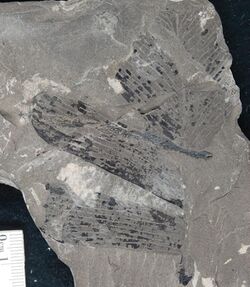Biology:Ctenis
| Ctenis | |
|---|---|

| |
| Scientific classification | |
| Kingdom: | Plantae
|
| Division: | |
| Class: | |
| Order: | |
| Genus: | Ctenis Lindley & Hutton 1834[1]
|
| Species | |
| |
Ctenis is a genus of fossil foliage attributable to the Cycadales, being one of the most common genera of cycad fossil leaves in the Mesozoic.
Taxonomy
The genus was first erected by Lindley and Hutton in "The fossil flora of Great Britain",[2] based on material of Ctenis falcata from the Jurassic of Yorkshire. This species was later synonymized with Cycadites sulcicaulis, leading to the new combination Ctenis sulcicaulis[3]. Later, Seward,[4] Florin, and Harris[5] added details of the cuticle to the diagnosis of the genus.
Due to the leaves of Ctenis possessing characters unknown in any living cycad, Ctenis is thought to belong to an extinct lineage distinct from modern cycads, with a 2023 analysis finding that the genus was paraphyletic with respect to Dioonopsis and Pterostoma, with this group suggested to be the sister group to Cycadaceae, from which they split in the Permian period.[6]
Description
The leaves of Ctenis are once pinnate, and the pinnae have multiple parallel veins that often anastomosize (i.e. fuse together).[7][8] The cuticle of Ctenis has stomata with guard cells arranged in a random fashion, and the stomatal apparatus has often a cuticular ring surrounding the stomatal pit. The cuticular surface is usually striate.
Distribution
Though Ctenis-like leaves are known from the Late Permian Umm Irna Formation of Jordan,[9] Ctenis becomes more common from the Late Triassic onwards. In the Jurassic, many Ctenis species are retrieved from Europe, North America, and Asia.[10][7] In the Early Cretaceous, Ctenis is still found in Europe (i.e. in the Wealden[11]) and Asia,[12] but from the Late Cretaceous it seems to retreat to more Northern Latitudes in the Siberian region[13] and North America[14] and Southern latitudes in Australia. The last members of this genus are found in the Eocene of North America.[8]
Paleoecology
Little is known about the ecology of the Ctenis-producing plants. However, in the Big Cedar Ridge locality in Wyoming (Campanian), Ctenis is found in the fern wetland together with ferns from the Dipteridaceae, Gleicheniaceae, and Matoniaceae.[15] This suggests that at least some members of the genus inhabited wet environments with peaty soils.
References
- ↑ Lindley, J. and Hutton, W., 1834. The Fossil Flora of Great Britain, Vol. 2. Ridgway & Sons, London.
- ↑ Hutton, William; Lindley, John (1831). The fossil flora of Great Britain; or, Figures and descriptions of the vegetable remains found in a fossil state in this country /. London: J. Ridgway. doi:10.5962/bhl.title.102097. http://www.biodiversitylibrary.org/bibliography/102097.
- ↑ "Fossilplants.info". http://www.fossilplants.info/species.htm?id=F456DA84-C91F-E4E8-0FD9-30BA84286650.
- ↑ Seward, A. C. (1898). Fossil plants; a text-book for students of botany and geology, by A. C. Seward.. Cambridge: Cambridge University Press. doi:10.5962/bhl.title.21744. http://www.biodiversitylibrary.org/bibliography/21744.
- ↑ Harris, Thomas Maxwell; Miller, José; Millington, Wendy (1961). The Yorkshire Jurassic flora. London: BM(NH). doi:10.5962/bhl.title.118957. http://dx.doi.org/10.5962/bhl.title.118957.
- ↑ Coiro, Mario; Allio, Rémi; Mazet, Nathan; Seyfullah, Leyla J.; Condamine, Fabien L. (2023-06-11). "Reconciling fossils with phylogenies reveals the origin and macroevolutionary processes explaining the global cycad biodiversity" (in en). New Phytologist 240 (4): 1616–1635. doi:10.1111/nph.19010. ISSN 0028-646X. PMID 37302411.
- ↑ 7.0 7.1 Harris, Thomas Maxwell (1964). The Yorkshire Jurassic flora. Vol.2: Caytoniales, Cycadales, and Pteridosperms. London: BM(NH). doi:10.5962/bhl.title.118957. http://dx.doi.org/10.5962/bhl.title.118957.
- ↑ 8.0 8.1 Erdei, Boglárka; Manchester, Steven R. (2015-01-01). "Ctenis clarnoensis sp. n., an Unusual Cycadalean Foliage from the Eocene Clarno Formation, Oregon". International Journal of Plant Sciences 176 (1): 31–43. doi:10.1086/678467. ISSN 1058-5893. https://www.journals.uchicago.edu/doi/10.1086/678467.
- ↑ Blomenkemper, Patrick; Kerp, Hans; Abu Hamad, Abdalla; DiMichele, William A.; Bomfleur, Benjamin (2018-12-21). "A hidden cradle of plant evolution in Permian tropical lowlands" (in en). Science 362 (6421): 1414–1416. doi:10.1126/science.aau4061. ISSN 0036-8075. PMID 30573628. Bibcode: 2018Sci...362.1414B.
- ↑ Kimura, Tatsuaki; Sekido, Shinji (1972). "Ctenis species from the Itoshiro sub-group (Lower Cretaceous), the Tetori group, central Honshu, Japan". Transactions and Proceedings of the Paleontological Society of Japan. New Series 86: 360–368. https://www.jstage.jst.go.jp/article/prpsj1951/1972/86/1972_86_360/_article/-char/ja/.
- ↑ Watson, Joan; Alvin, Kenneth L. (February 1996). "An English Wealden floral list, with comments on possible environmental indicators" (in en). Cretaceous Research 17 (1): 5–26. doi:10.1006/cres.1996.0002. Bibcode: 1996CrRes..17....5W. https://linkinghub.elsevier.com/retrieve/pii/S0195667196900026.
- ↑ Bugdaeva, E. V.; Markevich, V. S. (December 2009). "The coal-forming plants of rhabdopissites in the Lipovtsy coal field (Lower Cretaceous of Southern Primorye)" (in en). Paleontological Journal 43 (10): 1217–1229. doi:10.1134/S0031030109100049. ISSN 0031-0301. Bibcode: 2009PalJ...43.1217B. http://link.springer.com/10.1134/S0031030109100049.
- ↑ Vakhrameev, V.A. (January 1987). "Climates and the distribution of some gymsosperms in Asia during the Jurassic and Cretaceous" (in en). Review of Palaeobotany and Palynology 51 (1–3): 205–212. doi:10.1016/0034-6667(87)90030-3. Bibcode: 1987RPaPa..51..205V. https://linkinghub.elsevier.com/retrieve/pii/0034666787900303.
- ↑ Wing, Scott L.; Hickey, Leo J.; Swisher, Carl C. (May 1993). "Implications of an exceptional fossil flora for Late Cretaceous vegetation" (in en). Nature 363 (6427): 342–344. doi:10.1038/363342a0. ISSN 0028-0836. Bibcode: 1993Natur.363..342W. http://www.nature.com/articles/363342a0.
- ↑ "Wing - Big Cedar Ridge". https://naturalhistory2.si.edu/ETE/ETE_People_Wing_ResearchThemes_BCR.html.
Wikidata ☰ Q60898408 entry
 |

